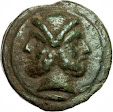Pre-Coin Roman Money
Roman
"money" from 1000 to 390 BC, or how did Rome pay their soldiers at
Veii in 400
BC if they started producing coins in 300 BC?
GHCC Money Show
January 17 – 19, 2019
rrdenarius.com
Rome paid soldiers for the first time at Veii about 400 BC. Before that extended campaign soldiers paid their expenses. Only moneyed men could fight, and collect glory and spoils.
Servius Tullius, the 6th king of Rome, reigned from 575 to 535 BC.He divided Roman citizens into Classes by wealth. The top class of citizen was required to have 100,000 asses where one As equaled a Roman pound = 327 grams. This level of wealth put a man in the equites or knights. Something was used for money before coins introduced in 280 BC.
Bronze was used for money. It seems likely that steelyard scales would have been used. They are better for weighing heavy items than the double pan balance.
Ab urbe condita 4.59 "... the senate decreed that the soldiery should receive pay from the public treasury. Previously, each man had served at his own expense.“
Ab urbe condita 4.60 "... The senators were determined to uphold a measure so happily inaugurated, they were themselves the first to contribute, and as coined money was not yet introduced, they carried the copper by weight in wagons to the treasury, thereby drawing public attention to the fact of their contributing. After the senators had contributed most conscientiously the full amount at which they were assessed, the leading plebeians, personal friends of the nobles, began, as had been agreed, to pay in their share. When the crowd saw these men applauded by the senate and looked up to by the men of military age as patriotic citizens, they hastily rejected the proffered protection of the tribunes and vied with one another in their eagerness to contribute." ]
Servius Tullius, the 6th king of Rome, reigned from 575 to 535 BC.He divided Roman citizens into Classes by wealth. The top class of citizen was required to have 100,000 asses where one As equaled a Roman pound = 327 grams. This level of wealth put a man in the equites or knights. Something was used for money before coins introduced in 280 BC.
Bronze was used for money. It seems likely that steelyard scales would have been used. They are better for weighing heavy items than the double pan balance.
The following quotes are from Livy -
[Titus Livius in his History of Rome spoke on
this.Ab urbe condita 4.59 "... the senate decreed that the soldiery should receive pay from the public treasury. Previously, each man had served at his own expense.“
Ab urbe condita 4.60 "... The senators were determined to uphold a measure so happily inaugurated, they were themselves the first to contribute, and as coined money was not yet introduced, they carried the copper by weight in wagons to the treasury, thereby drawing public attention to the fact of their contributing. After the senators had contributed most conscientiously the full amount at which they were assessed, the leading plebeians, personal friends of the nobles, began, as had been agreed, to pay in their share. When the crowd saw these men applauded by the senate and looked up to by the men of military age as patriotic citizens, they hastily rejected the proffered protection of the tribunes and vied with one another in their eagerness to contribute." ]
The first two pictures show one week's pay (about 15 US pounds) in bronze bars, cakes and panes. Two of the bars are Ramo Secco. The largest is 2.2 Kg. The bars are weighed on a Steelyard Scale.
Cupid is my favorite Steelyard Scale weight. It was not heavy enough to weigh the bronze bars.
The two pan scale has four weights: 1 As, VI (six) VNCIA, III (three) VNCIA and one uncia (the last weight is later and has letters to designate one Roman ounce) = 600 grams.
The bar in the right pan is one with a mark (X).
I will post a coin on the next page. That coin is from the first series assigned to Rome and is dated 280 BC, or a century plus before the war with Veii.
What is Money? According to D. B. Holland in "Money in the Late Roman Republic" it is:
I will post a coin on the next page. That coin is from the first series assigned to Rome and is dated 280 BC, or a century plus before the war with Veii.
What is Money? According to D. B. Holland in "Money in the Late Roman Republic" it is:
Something used as:
•Medium
of exchange: recognized by many to have value, facilitates trade;
examples: land, cattle, sheep, bullion, shells, etc.
•Measure
of value: to determine equivalent trade value, ie – how many eggs equal a modius of flour
•Unit
of account: to
balance
books,
determine tax rate, set
social standing for senate & army (see below)
•Store
of
wealth, needs to be something that is: “small”, will hold value, will not
degrade with time
•Means
of payment: pay soldiers and other military expenses, pay taxes,
buy (luxury) goods from outside community
By this definition, the cast bronze is
money and thus worthy of a display at the Money Show! Some early bronze shapes
were shown in the flat coin case.
•Aes Rude
- Molten bronze
cooled
in water
•Broken
plates
or panes
•Aes Formatum –
Ingots, bars and
pieces
–With
and without marks, Ramo Seco
•Shells
•Astralagas,
knuckle bones
•Broken
tools: knife blade, ax
Note the pic below has a piece of a knife blade and two axes.
•Decorative
Shapes: rings, palmetto, tear drop, bars, acorns, etc.
The shapes are above. Below are some aes rude with marks.
I will post a coin on the next page from
the first series issued in Rome.





















No comments:
Post a Comment